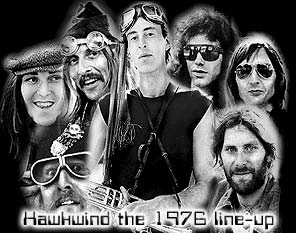
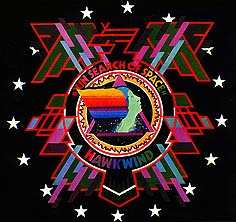 1971
saw the release of Hawkwind's 2nd album:
1971
saw the release of Hawkwind's 2nd album: X - In Search of Space
It is the first record that features the striking graphics of Barney Bubbles, including photos by the seemingly ever-present photographer Phil Franks. Barney also did most of the work on The Hawkwind Log, a booklet that came with the album, featuring a collage of texts and photos - supposedly a found log-book of a spaceship, containing the cryptic last notes and contemplations of it's travellers through space - another seed of Calvert's concept of the soon to come Space Opera - the Space Ritual.
The Log also features several Calvert poems like Co-Pilots of Spaceship Earth and Ten Seconds of Forever - pieces, that soon became standards of the Calvert / Hawkwind live - repertoire.
 ISOS
established Hawkwind's style of hynotic free-flowing improvisations, accompanied
by tribal rhythm's - in contrast with some acoustic guitar based pieces,
remnants of Brock's busking days, often with a melancholic touch.
ISOS
established Hawkwind's style of hynotic free-flowing improvisations, accompanied
by tribal rhythm's - in contrast with some acoustic guitar based pieces,
remnants of Brock's busking days, often with a melancholic touch.
The band's sheer omnipresence on the live circuit and all kinds of free festivals had secured them a large and loyal live audience already - that consequently also resulted in the band's first significant appearance in the charts.
Though
Calvert was already much involved in the band's live appearances, his
musical / poetical contributions didn't show up on those early studio
recordings - simply, because no one thought that these powerful live-combinations
could really be transferred to and 'work' in the studio.
However, ISOS has been re-released (digitally
remixed etc.) and now contains 3 Calvert song-collaborations: SILVER
MACHINE (the soon to become top-ten hit) / SEVEN BY SEVEN and a fantastic
raw-energised version of BORN
TO GO - one of the band's best live performances, incl. some frantic
Calvert vocals -
probably the
earliest example of (psych)-Punkrock.
| Read
an article
from the Melody Maker from Jan. '71 - shortly after the release of
ISOS. Read an (extensive) article from FRIENDS, July 1972 - HW touring Germany; a band breakdown; odyssee included. |
Calvert's guest appearances soon turned into the status as the band's permanent 'resident-poet'. In between Hawkwind's psyche-punka-delic songs and sound-collages, Calvert turned up out of the fog and psychedelic light-shows, delievering his intense poetry-performances plus texts by his friend and SF-author Mike Moorcock. And if ever anybody mistook the band for yet another incarnation of love-and-peace naivety, than Calvert's distinctive, brooding and at times aggressive performances provided the definite crack of the stereotype. In fact, his performances of Sonic Attack and In the Egg would even today fit into any experimental-industrial-oriented performance - though the audience probably wouldn't believe that this was already done 3X years ago.
| Read an appreciation of Hawkwind's influence on the industrial music scene - by Nigel Ayers of Nocturnal Emissions. |
This
combination created - probably up to now - the most intense and - strangely
enough - succesful blend of poetry and modern, electronic
music. 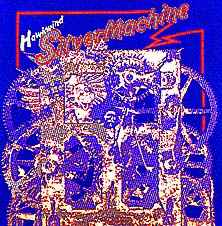
Calvert's performances went down extremly well with the audiences and
his part extended to singing and songwriting.
Though the band had
already gained a great following among the psychedelic community
by often playing at free gigs and numerous performances up and down the
country, the big commercial breakthrough came with Silver
Machine - one of the first songwriting collaborations of Calvert
and Brock - and rocketed into the charts to become
a million-seller-song.
| > LISTEN to Calvert telling the story around the release of SILVER MACHINE < |
"We were
asked if we would mind if they'd put Silver Machine out as a single. It
was just one of the songs in the Space Ritual. I never thought of making
a single - I thought singles are really something from a different industry
we were in. When it was suggested and everybody agreed that it was a good
idea to do it, I was so naive in those days that I couldn't see any way
that if you made a single it wasn't a hit.
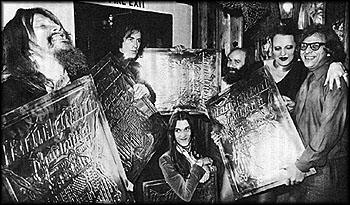 I assumed if you got into the process of making singles than you're
in the busineess of making hit singles and that was it.
I assumed if you got into the process of making singles than you're
in the busineess of making hit singles and that was it.
So, it didn't surprise me that it got to the top of the charts at all.
I think I would have been surprised if it hadn't - not because I thought
it was fantastic - subsequently I found out that this is not what most
of the singles do.
But that was how naive I was then..."
Silver
Machine was
probably the first song that introduced Pataphysics
and Ubu-esque humour to modern rock-music - and even got the band
their first TV-performance on....
Top of the Pops!
Read
an article from Let it Rock; Dec. Jan. '72 - on the success
of SILVER MACHINE
and how it helped Hawkwind to produce their ambituous upcoming SPACE
RITUAL.
See the original SILVER
MACHINE ad by Barney
Bubbles.
![]()
Hawkwind
appeared as one of the top-bands at Glastonbury Fayre
with Calvert taking over the lead vocals.
The legendary Calvert, writer and conceptual
thinker, has built up a reputation through his extraordinary ideas.
lt was he who devised the framework of the Space Ritual
The Hawkwind Log accompanied Hawkwind's In
Search of Space album was partly constructed by Calvert. lt is one
of the most impressive correlations of relative ideas about out perspective
and proportion in the universe that has ever emerged from the rock culture.
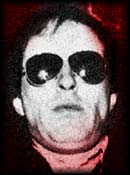 Despite his effect upon the group's development, Calverts membership of
the group has appeared irregular in the past. There have been periods
when he just seemed to depart and return without warning. He seems to
be migratory:
Despite his effect upon the group's development, Calverts membership of
the group has appeared irregular in the past. There have been periods
when he just seemed to depart and return without warning. He seems to
be migratory:
> "Oh well,
you can't be there all of the time. You can only be there some of the
time. Yes, actually I wasn't always but I have been recently. I've been
ill, you see. So I disappeared for a while and came back. I don't think
I keep doing it actually.
I think I've done it once. I was laid off, as it were." <
from: Melody Maker's 'Hawkwind File'
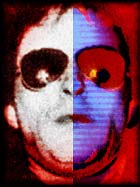 After the succesful Glastonbury gig, that has also been released as a
part of a festival's compilation album, plans were forged to put him on
as the permanent vocalist, but Calvert's recurring
mental problems - he was a self confessed 'hypomaniac
- manic-depressive' - soon caused him to back away from such a
close involvement
After the succesful Glastonbury gig, that has also been released as a
part of a festival's compilation album, plans were forged to put him on
as the permanent vocalist, but Calvert's recurring
mental problems - he was a self confessed 'hypomaniac
- manic-depressive' - soon caused him to back away from such a
close involvement
So, it was also due to these infrequent appearances that Calvert never got involved in the studio-recordings from that period, though he was frequently given credit for the conceptual influence.
| Read
an extensive introduction to Hawkwind's Space
Ritual line-up - from the Melody Maker; April '73 |

"A
visual mind-blower in the shape of an enormous strobe light
trained upon the audience has its intensity doubled by the paranoia-inducing
random flashing spotlight which causes
temporary
blindness at approximately ten minute intervals. And then there are the
two smaller strobes, one green and one red, which turn Hawkwind into twitching
green eyed monsters prowling the depths of a timesless reverberating hell....Through
it all throbs and shrieks their ethereal music, and then there are the
four bass drums thundering against the edges of your mind."
- official Hawkwind gig promotion by United Artists

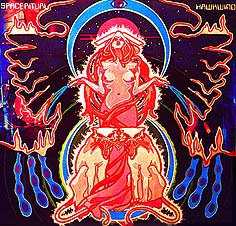 "I don't
think there was any other band that was doing anything quite like this.
Playing long stretches of free-form electronic music with
spoken poetry being read to it in a way that earlier poets read their
work to Jazz. But it seemed at the time we were doing it as a sort of
inevitable extension of the whole experimental feeling there was in these
days."
"I don't
think there was any other band that was doing anything quite like this.
Playing long stretches of free-form electronic music with
spoken poetry being read to it in a way that earlier poets read their
work to Jazz. But it seemed at the time we were doing it as a sort of
inevitable extension of the whole experimental feeling there was in these
days."
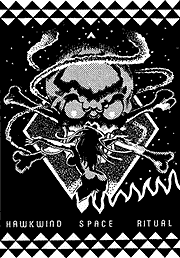 The
double live-album Space
Ritual is the only recorded document of these days, featuring various
of Calvert's poetry performances, like the all-time-Hawkwind-classic Sonic
Attack and (still the closing number of all HW-gigs) Welcome
to the Future.
The Space Ritual
involved a massive amount of sound and lighting equipment
that was almost completely financed from the incomes of Silver
Machine.
The
double live-album Space
Ritual is the only recorded document of these days, featuring various
of Calvert's poetry performances, like the all-time-Hawkwind-classic Sonic
Attack and (still the closing number of all HW-gigs) Welcome
to the Future.
The Space Ritual
involved a massive amount of sound and lighting equipment
that was almost completely financed from the incomes of Silver
Machine.
"The astonishing success of The Space Ritual must
have been the most succesful blend of poetry and music ever been sold
on a record. It's still the best selling album the band has produced so
far."
|
>
LISTEN
to Calvert
talking about his role as the band's 'resident poet' and the success of the Space Ritual < |
|
"The Space Opera, which is really a ritual was Bob
Calvert's idea. It's almost a religious ceremony -
some of our gigs have that kind of atmosphere. Most of the material was written by Bob and concerns a fantasy about seven cosmonauts who are travelling through space in a state of suspendedanimation. The Space Opera is an audio visual portrayal of their fantasies and dreams as they travel through space. It's a very flexible situation in which there is all kinds of scope to bring up subjects which are relative to our society in more realistic terms of ecology." - Nik Turner |
||
|
||
| The
Starfarer's Dispatch I would have liked you to have been deep- Frozen too, and waiting Still as fresh in your flesh For my return. But your father refused To sign the forms To freeze you. Let's see you'd be, what, About sixty now. And long Dead by the time I get Back to Earth. My time- Suspended dreams were full Of you as you were when I left. Still under age. Your android replica Is playing up again. It's no joke. When she comes She moans Another's name. |
Based
on a bundle Calvertian ideas, but with the brain behind it being
in and out of mental hospitals during production hase, the Space Ritual's
concept remained somewhat vague in the final stage-show. However, the initial concept focussing on the dreams of starfarers travelling in suspended animation, appeared throughout numerous songs & poems like THE AWAKENING, TEN SECONDS OF FOREVER and WELCOME TO THE FUTURE and included as much references to 'earthly' subjects - a good example for the initial idea gives Calvert's poem The Starfarer's Dispatch. Apart from Calvert's poetical concept, and his performances that formed a kind of structural backbone of the entire show - the Ritual also included other dancers and performers - most prominently the exuberant ... |
| ...Miss Stacia |
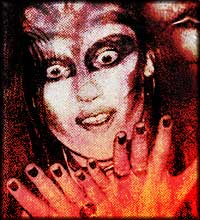 A self-taught
mime & dancer, she got the kick for performances when seeing Arthur
Brown's expressive performances - another
collab
A self-taught
mime & dancer, she got the kick for performances when seeing Arthur
Brown's expressive performances - another
collab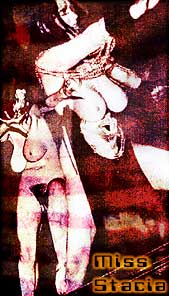 orator
of Calvert in the years to come. orator
of Calvert in the years to come.
Stacia joined the band in 1971 and toured with them for the following
4-5 years. Her performances were completely improvised - no one
could ever tell what she would do - but her extraodinary costumes
were quite often dropped completely. Amongst
other dancers, the show featured spectacular light & slide shows
by their soon-to-become-famous lightcrew: LIQUID
LEN AND THE LENSMEN - and also the reknown 'resident
DJ'
Andy Dunkley, who got the audience in the right mood
before the Ritual began, and who also set off the show with it's
very own tailor-made Countdown.
|
| But it wasn't all about space-ships,
time-travelling, cloning and freaked-out-science-fiction-formulas... Hawkwind and Calvert didn't earn their street-cred for nothing - they surely knew what was going on - or was bound to come up soon down here on earth - on it's capitol and capitalist-ridden streets... |
the Punk Pre-Cursors....
| I'm
an urban guerilla I make bombs in my cellar I'm a derelict dweller I'm a potential killer I'm a street fighting dancer I'm a revolutionary romancer I'm society's cancer I'm a two-tone panther So let's not talk of love'n flowers And things that don't explode We've used up all of our magic powers Trying to do it in the road I'm a political bandit You just don't understand it You took my dream and canned it It's not the way I planned it I'm society's destructor I'm a petrol bomb constructor I'm a cosmic light conductor I'm the people's debt collector So watch out Mr. Business Man Your empire's about to blow I think you'd better listen, man In case you did not know |
Another
highlight of the Calvert / Hawkwind collaboration was
- the 1973 follow-up single to SILVER MACHINE - and actually a much better song. Urban Guerilla features Calvert as the original vocalist and he delievers one of his finest performances here - but, as it often happend in the later years of his career, misfortune struck him at a very promising moment. The release coincided with a series of bombings by the I.R.A. in London and United Artists, Hawkwind's label at the time, began to fear they might be the next target. So, just as the Guerilla was climbing up the charts, the BBC and other stations refused to give this 'dangerous' and seemingly terrorism - supporting song any more airplay - eventually UA withdrew the record from further release. Being the
composer of a supposedly pro-terrorist song, Calvert had to give
numerous interviews and face quite a hostile public reaction -
like a lot of the 'heroes' of the yet unborn Punk-era,
for which URBAN GUERILLA is one of THE musical precursors.
|
|
> > LISTEN
to Calvert on the story and trials around URBAN GUERILLA
< < > > LISTEN to an excerpt of URBAN GUERILLA < < |
| "I
was sort of alarmed to see how many people thought that an Urban
Guerilla was something to be. It didn't surprise me that it
was banned by the BBC at all. In fact I expected it to cause a lot
of controversy - it made front pages of the newspapers and I was
heavily taking to task. I had to give interviews which were quite
embarrasing - because the statements I'd made in the song - which
obviously weren't a refutation of guerilla tactics by any means
at all. I meant it as a metaphor for an attitude. I suppose it got me a file opened by the Special Branch or at least by the Home Office. Obviously you can't get away with something like that." |

|
towards the 1st departure... though things were - despite the back-set of Urban Guerilla - developing fine for Hawkwind in general and Calvert's role was meant to be extened to the band's lead vocalist, various problems arose that made him drift apart from the band - mental and artistic aspects (that don't necessarily exclude each other, of course....) |
|
"For
some months, Robert Calvert was the lead vocalist, but problems
centering around the unstabling effect on both the mind and the
ego forced him into a mental hospital. |
|
"My whole
approach to work is different from that of the Hawkwind's. They're improvisers, but I meditate for a long time over something before I commit it." |
The
combination of supplying the band with the mayor conceptual background
and its 'aura', so to speak, but not being able to realize his own
ideas completely led to an increasing frustration. At the time Calvert said he believes Hawkwind to be primarily an instrumental band, with the lyrics and concepts secondary in importance. |
Asked if he feels satisfied with the way the music represented the ideas and concepts contained in his lyrics, Calvert replied:
Improvisation has to be limited to some series of links to keep it all going in the same direction otherwise it would get totally out of hand.
finally...
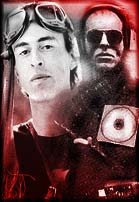
 Though
it is unlikely he will perform on stage with HW in the nearest future,
his presence as lyricist and general creative force will continue to
add a vital extra dimension to the band.
Though
it is unlikely he will perform on stage with HW in the nearest future,
his presence as lyricist and general creative force will continue to
add a vital extra dimension to the band.
Talking to him the last time, he seemed bitter about the situation claiming
that the rift had occured because he was too individually-creative a
force for the band to take. Since then he has spent another period in
a mental hospital, and is getting himself well and truly together to
work on a solo-record.
FRENDZ
- 7/72 - by Nick Kent
![]()
 |
In
mid -'73 he backed out of his involvement with Hawkwind, only guesting
from time to time at the odd gig. But the relation to the band remained a good one - with most of the band members appearing on Calvert's first solo-album: |
 |
| Captain
Lockheed and the Starfighters, released in 1974. One year later Lucky Leif and the Longships followed - produced by Brian Eno. |
||
..but fortunately Calvert's absence didn't last too long...
...and the best songs 'n years in this story are yet to come...
clockwise:
| Nik Turner * Simon King * Dave Brock | ||
| Robert Calvert | ||
| Simon House * Alan Powell * Paul Rudolph |
...after the return of Calvert in 1976
Read all about it in
of another action-packed episode of the Calvert-Collab-Relations story with HAWKWIND
